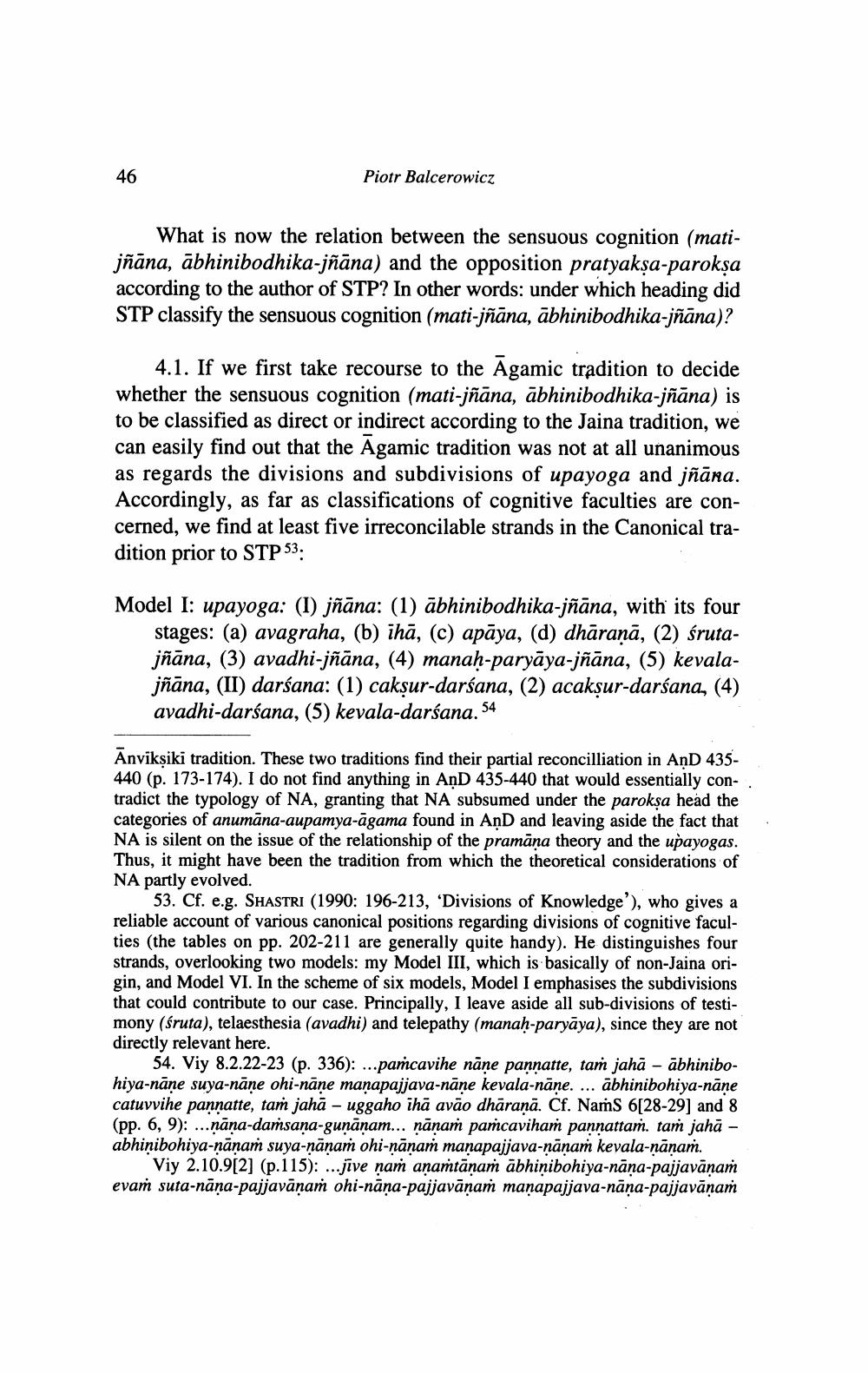________________
46
Piotr Balcerowicz
What is now the relation between the sensuous cognition (matijñāna, ābhinibodhika-jñāna) and the opposition pratyakṣa-paroksa according to the author of STP? In other words: under which heading did STP classify the sensuous cognition (mati-jñāna, ābhinibodhika-jñāna)?
4.1. If we first take recourse to the Agamic tradition to decide whether the sensuous cognition (mati-jñāna, ābhinibodhika-jñāna) is to be classified as direct or indirect according to the Jaina tradition, we can easily find out that the Agamic tradition was not at all unanimous as regards the divisions and subdivisions of upayoga and jñāna. Accordingly, as far as classifications of cognitive faculties are concerned, we find at least five irreconcilable strands in the Canonical tradition prior to STP 53:
Model I: upayoga: (1) jñāna: (1) ābhinibodhika-jñāna, with its four
stages: (a) avagraha, (b) ihā, (c) apāya, (d) dhāraṇā, (2) śrutajñāna, (3) avadhi-jñāna, (4) manaḥ-paryāya-jñāna, (5) kevalajñāna, (II) darśana: (1) cakṣur-darśana, (2) acakṣur-darśana, (4) avadhi-darśana, (5) kevala-darśana. 54
Anvikṣiki tradition. These two traditions find their partial reconcilliation in AnD 435440 (p. 173-174). I do not find anything in AnD 435-440 that would essentially contradict the typology of NA, granting that NA subsumed under the paroksa head the categories of anumāna-aupamya-āgama found in AṇD and leaving aside the fact that NA is silent on the issue of the relationship of the pramana theory and the upayogas. Thus, it might have been the tradition from which the theoretical considerations of NA partly evolved.
53. Cf. e.g. SHASTRI (1990: 196-213, 'Divisions of Knowledge'), who gives a reliable account of various canonical positions regarding divisions of cognitive faculties (the tables on pp. 202-211 are generally quite handy). He distinguishes four strands, overlooking two models: my Model III, which is basically of non-Jaina origin, and Model VI. In the scheme of six models, Model I emphasises the subdivisions that could contribute to our case. Principally, I leave aside all sub-divisions of testimony (śruta), telaesthesia (avadhi) and telepathy (manaḥ-paryaya), since they are not directly relevant here.
54. Viy 8.2.22-23 (p. 336): ...pamcavihe nane pannatte, taṁ jahā – ābhinibohiya-nāṇe suya-nāṇe ohi-nāņe maṇapajjava-nāne kevala-nāne. abhinibohiya-nāņe catuvvihe pannatte, tam jahā - uggaho ihā avão dhāraṇā. Cf. NamS 6[28-29] and 8 (pp. 6, 9): ...nāṇa-damsana-guṇāṇam... ṇāṇam paṁcaviham pannattam. taṁ jahā abhinibohiya-nāṇam suya-nānam ohi-nāṇam manapajjava-ṇāṇam kevala-nāṇam.
Viy 2.10.9[2] (p.115): ...jive nam aṇamtānam ābhinibohiya-nāṇa-pajjavāṇam evam suta-nāṇa-pajjavāṇaṁ ohi-nāṇa-pajjavāṇaṁ maṇapajjava-nāṇa-pajjavāṇam




